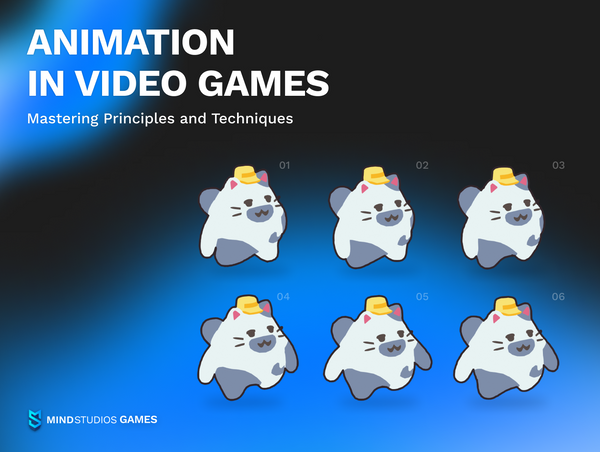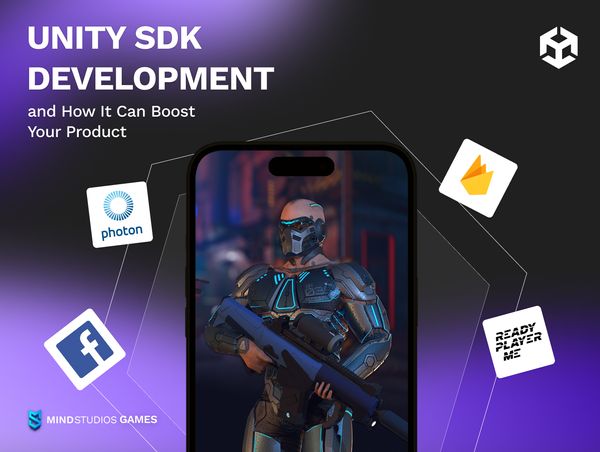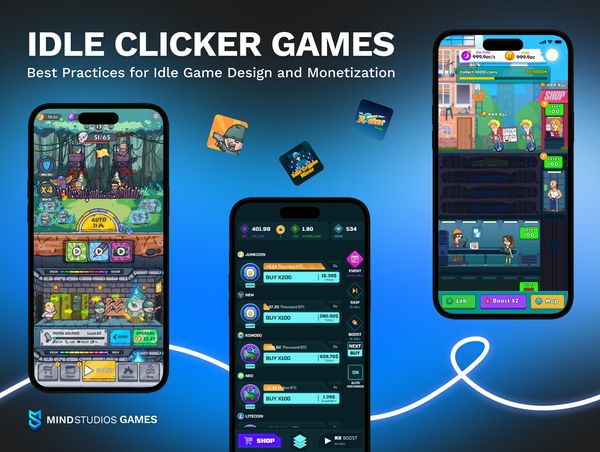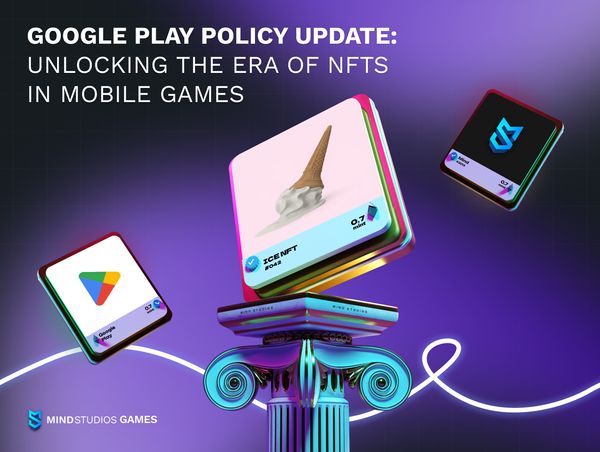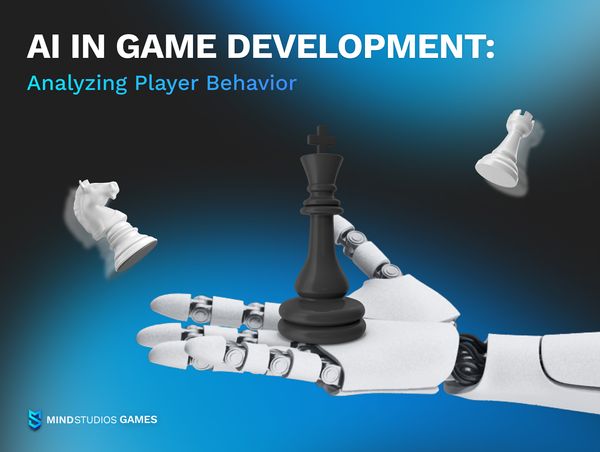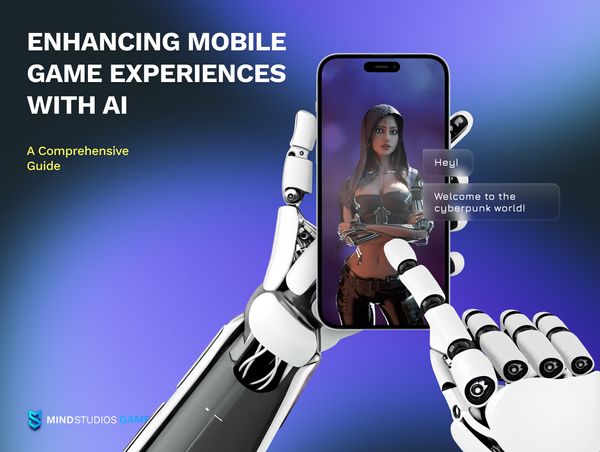
Artificial intelligence is coming into every home and every industry. Mobile game development industry is not an exception. This evolution, like any other technology breakthrough, has its pros and cons, defenders and skeptics. As a curious bunch with eyes on the tech innovation, we at Mind Studios Games have been diving into the topic of AI for games since a while back.
Can AI make mobile games better? In our opinion, yes. We’ve tried it, and there are a number of things smart robots can help with. Is AI an unambiguous solution? No. There are issues to solve still, and challenges to overcome before we can say with confidence that AI game creation is the future of mobile gaming.
In this article, we’ll be diving a bit into the topic of using AI in game development. This article will focus on the AI integration into games and how it can make games better for players and game owners. If you’re interested in the developer side and how AI can enhance the development process itself — stay tuned, that article is coming up soon as well.
Uses of AI for mobile games
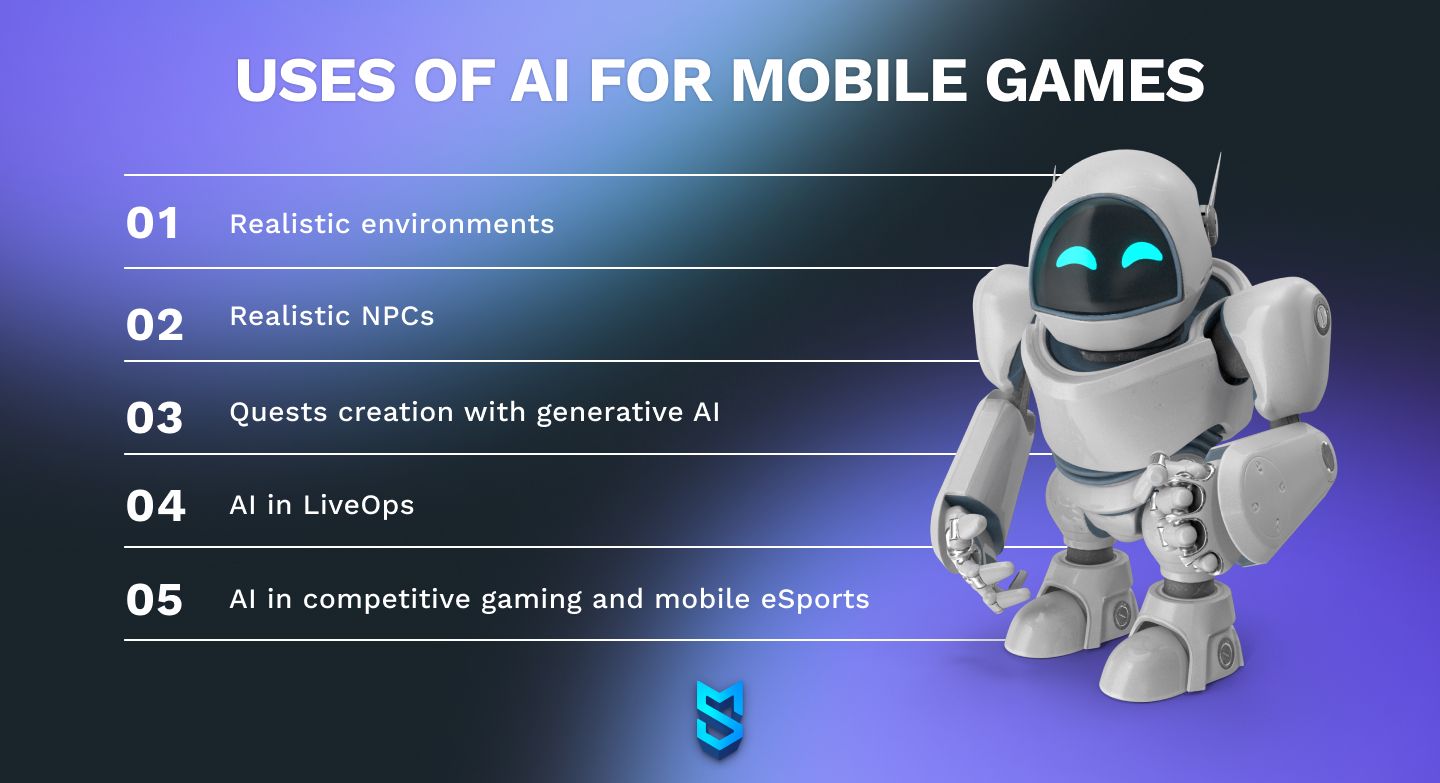
Besides game personalization, AI in game development has other uses, of course. Here are just some examples.
Realistic environments
The debate about generative AI is quite fierce. The ethical side of the technology is a huge issue that needs to be addressed. However, artsy generative AI in game development, in particular, has uses that do not infringe on artists but empower them.
One of the techniques video games can benefit from is upscaling — the enhancement of visuals based on high-resolution photos. This technique allows, among other things, to create landscapes that preserve visual details when zoomed in, have realistic textures, and change depending on the environment factors (time of day, weather, angle of light, etc.).
Realistic NPCs
The second most talked about option for AI use. In most cases, minor NPCs in games lack in:
- Distinct appearance
- Unique characterization
- Diverse dialogues
It’s especially noticeable in open-world games and large RPGs — players stumble upon NPCs that look the same and talk the same as other NPCs. It’s boring. However, from a game creator’s point of view, spending their artists’ and writers’ time (and, consequently, the company money) on making each NPC completely unique is just wasteful. After all, players encounter most of them once, or just a couple times.
AI can help with this. By feeding the algorithm a big chunk of data, it’s possible to create NPCs that will all be different — and do it fast, without wasting much time of your human employees.
From appearance to personalities to speaking patterns and branched dialogs — you can diversify everything related to NPCs without wasting resources.
Quests creation with generative AI
Small quests and time-limited events are one of the surest ways to hold players’ attention while you’re creating new sections of your game’s main storyline. But to create such small quests and events, your game designers and content creators also need to spend time.
Generative AI algorithms like ChatGPT can offer a multitude of options for quests based on pre-defined parameters. By employing generative algorithms on shorter quests and events, it’s easier to avoid one of the AI pitfalls — its inconsistency (we’ll talk about it below). You’ll be saving your human employees’ time while still obtaining content to keep players entertained for a while.
AI in LiveOps
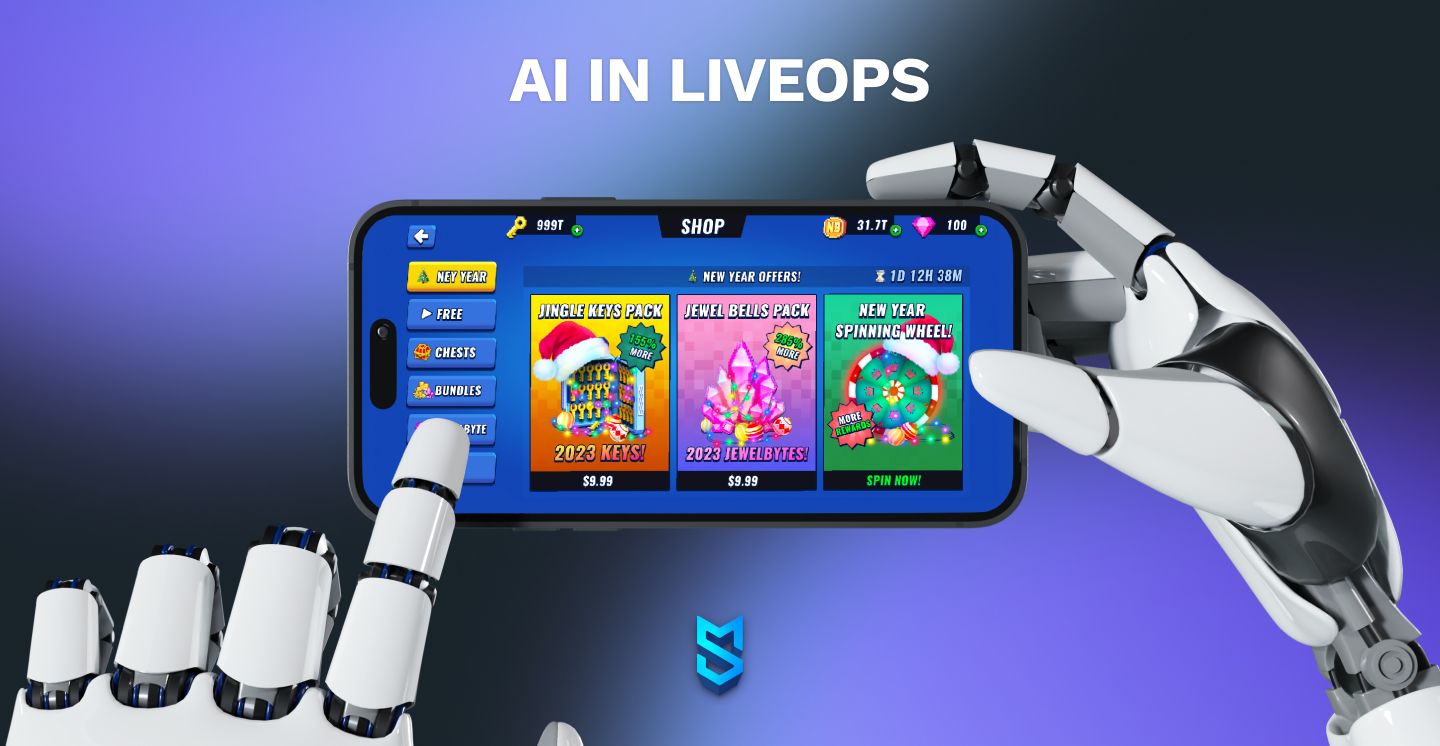
LiveOps — short for “live operations” — mean any updates to the game that can be done “on the go”, so to speak, without unrolling a full new version of the game.
Back in the day, LiveOps mostly included bug fixes developers could finally do when games moved to online downloads instead of purchasing discs and cartridges. Nowadays, though, many more things are included under this term. Basically, anything that affects player experience and that you can change in the game without a new release is LiveOps:
- Bug fixes
- New features
- Live events
- In-game purchases
- Game content
Artificial intelligence can be of huge help to your game’s LiveOps.
AI-based predictive analytics allow developers to better understand player behavior. This, in turn, makes it possible to effectively tailor experiences and optimize the gaming environment, ultimately leading to more satisfied and engaged players.
Here are the main areas where AI can help make games more engaging and, in the long run, more successful.
- Dynamic difficulty adjustment. Before the introduction of artificial intelligence in game design, it was impossible for game developers to tailor games to each player individually — simply because we can’t follow up on every player’s individual traits. However, AI algorithms can do just that by processing playing data of each player in real time. Now, it’s possible to customize the difficulty individually to make players stay with the game longer.
- Player behavior prediction. Similarly to difficulty adjustment, players’ in-game behavior prediction helps tailor in-game content to make it more personally engaging. A subset of this is the player retention prediction — an algorithm that can alert developers to player behaviors signifying loss of interest. With this information, developers can try to keep players interested with challenges and events before it’s too late.
- In-game purchasing predictions help developers tailor monetization strategies. An algorithm can calculate the best time to offer player purchases and choose items at the optimal price the player is ready to give.
- Fraud detection. Player behavior analysis helps identify individual patterns, and when these patterns change significantly, the AI used in game development can alert developers or players themselves of possible account theft or fraudulent activity.
- Prediction of optimal time for events and challenges. These days, games hold thematic event for major holidays in the area the game is played. This can be enhanced with AI-based predictive analytics, making events timed better and their content more tailored to players’ tastes.
- Proactive bug detection. By analyzing player activity, AI algorithms can identify bugs before players report them. Fewer bugs make for better player experience, enhancing game reputation and increasing loyalty. Besides, the earlier the bug is detected, the cheaper it is to fix.
AI in competitive gaming and mobile eSports
The eSports have gone mobile, following the overall video game trends where mobile segment has more revenue than all other platforms combined. And using AI in eSports has huge benefits to everyone involved: players, spectators, and competition owners.
The benefits of artificial intelligence in games played competitively include:
- Matchmaking optimization. When creating competition matches, a lot of data goes into consideration, like each player’s/team’s experience and previous performance, playing style, preferences, skill levels, and more. These loads of data can sometimes be quite large, especially for big competitions and players with a long history of participation.
With the help of AI, it’s easier to find players that are similarly matched. And similarly matched players make for more unpredictable rounds, providing a more engaging competition experience for both players and spectators. - High-quality virtual coaches. Same as ML in traditional games can offer NPC evolution, AI-backed virtual coaches can help players skill up by analyzing games in real time and then offering advice.
- Automated highlights and replays. Algorithms analyze data faster than humans, so it’s possible to create truly engaging replays with the most memorable game moments instantly. AI bots can also give off real-time commentary.
- Anti-cheat systems. Competitions must be fair, otherwise where’s the fun in that, right? By feeding an AI algorithm data on rules, possible cheats, and overall history of playing, it’s possible to build a system that will instantly recognize suspicious activity and report it to competition organizers.
Challenges of AI in game development
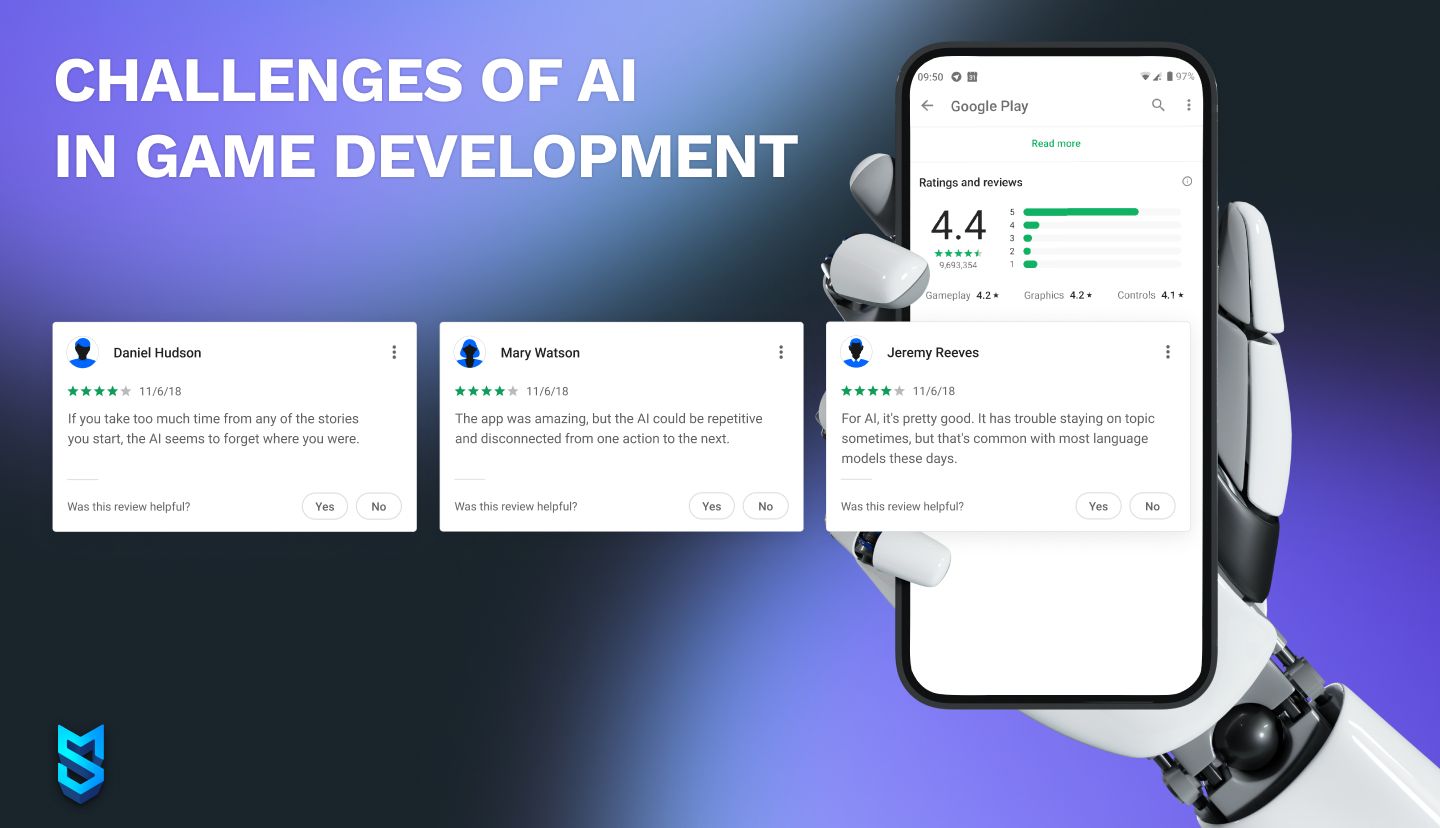
It can’t be all sunshine and rainbows, can it? AI in video game development is a relatively new thing, and there are still obstacles to its spread. Some challenges AI is facing aren’t unique to only game development, and some others are. Let’s go over them.
Inconsistency |
For now, the AI services available to the public have the memory of a goldfish. ChatGPT scrapes its databases to search for an answer to users’ questions each time, even if it’s a follow-up question and not a new prompt. It doesn’t retain the data on what it answered just a couple questions ago, sometimes repeating itself and other times giving out an answer that’s complete opposite to previous ones, just because its training data has contradictory information. At the stage of AI development where we are now, we’re yet to see an AI algorithm that can build a somewhat long story or a set of dialogs that are consistent through and through. Meaning, your AI algorithms will still need heavy supervision from human content creators. |
Ethical issues |
Depending on what kind of AI algorithm you’re planning to use in your game, the ethical issues might differ, as there are several of them:
|
Lack of true creativity |
While artificial intelligence is a great asset to diversify games, it only works within the limits of data it has been trained on. It isn’t capable of “thinking outside the box”. For quality results from AI systems in the creative fields of art, writing, game design, we need to use AI as an assistance tool, not replace humans with algorithms. |
Cost of necessary computational resources |
Presently, AI is not cheap, as training even a semi-complex algorithm requires substantial computational power and a lot of data. Small game development companies might struggle to afford big custom AI solutions. |
Data quality and quantity |
It’s been speculated that AI algorithms can’t be trained on AI-generated data, only on naturally procured human data, otherwise the results will deteriorate. So for the algorithm to keep improving, the flow of data into it needs to be massive, continuous, and proven to be human-generated. |
Interpretability |
Misinterpreting data can happen even with traditional analytics, and AI algorithms are much more complex. This means you’ll need specialists adept at AI to successfully utilize the technology. |
Chances of overfitting |
Algorithms tend to narrow down the results based on the data, that’s what they’re made for — to help choose the best case scenarios from a flood of information. But that narrowing down can be too much and the algorithm becomes unable to adapt to new situations. The AI in game design needs to be constantly monitored by human game designers to avoid becoming too specific. |
All these challenges are conquerable with the help of humans — AI researchers as well as game development specialists. However, if you wish to involve AI in game making, you need to be aware of and address them properly.
Best practices and practical tips for implementing AI in mobile games
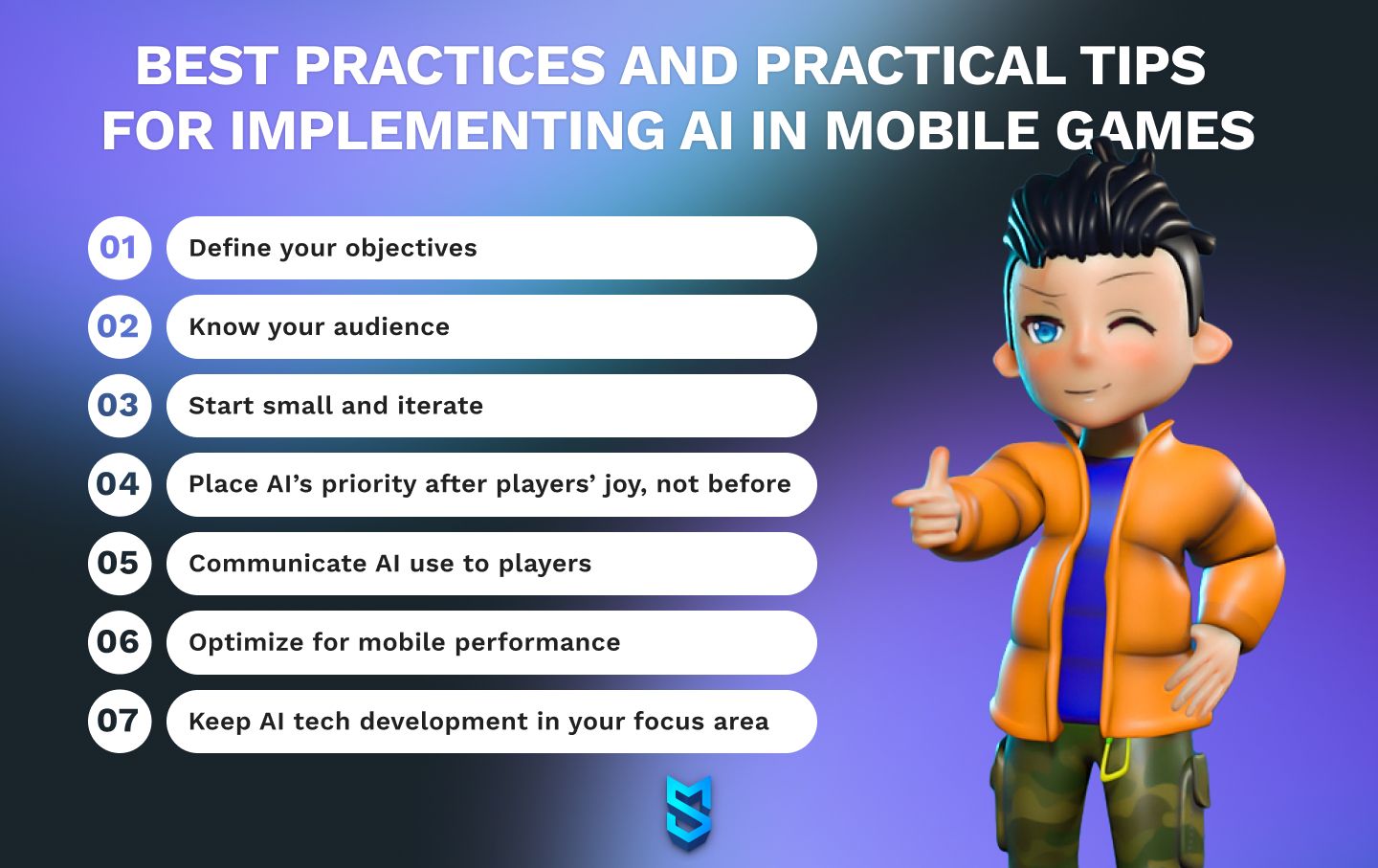
So how do you make the best use of AI in game development and avoid its pitfalls? In our experience, the best practices are the ones we’d employ in any game creation, with or without AI. AI is but a useful tool that makes things easier, it’s not a solution to every problem. At the same time, it’s important to consider the specifics of AI when addressing the usual game development pitfalls. Here’s a list of recommendations we at Mind Studios Games swear by.
#1 Define your objectives
Why are you developing a game, and why do you wish to employ AI in it? Without a clear objective for AI use, it’s just money down the drain. And as we mentioned above, AI solutions don’t come cheap, in most cases.
An experienced team of game developers will advise you on the use of proper AI tool depending on your goals so that it doesn’t just siphon your funds off but will enhance your game.
#2 Know your audience
It’s a must for any product or service, and AI game development is no exception. What do your players expect from your game, and which AI tools can help you deliver on those expectations?
Investing in a technology as potentially costly as artificial intelligence without making sure it’s a feasible solution might turn out not the best decision. Furthermore, when you do know your audience and its expectations, your chances to build a successful algorithm will rise exponentially.
#3 Start small and iterate
In commercial game development, a lot comes down to money. If it’s not the potential profits, it’s the necessary investment. That’s why we always advise our clients to start with simpler and smaller — and cheaper — algorithms, and then scale up when the balance is found.
With gradual increase in algorithm complexity from one iteration to the next, you’ll be able to observe:
- How well the AI works with your game’s mechanics;
- How your game designers are handling the AI involvement;
- How your players react to the AI’s input into the game;
Interactive development will make it possible to test your AI solution thoroughly, collect feedback from multiple sources, and make data-based decisions. Additionally, you’ll be collecting data that you can later use to train this same AI.
#4 Place AI’s priority after players’ joy, not before
Not just AI. To create a successful game, your players’ joy should be your very first priority. Games are made to entertain, after all. Even educational games — they exist to make studying more enjoyable. However sophisticated and impressive the algorithm you build is, if it doesn’t contribute to the game’s ability to entertain, it’s useless.
Design AI systems with the player in mind, listen to players’ and game designers’ feedback, and make adjustments to the algorithm where necessary.
#5 Communicate AI use to players
The best kind of feedback from players comes when said players know what they’re commenting on. If you use AI in game making, and it affects players’ experience, you should tell players about it. This way, you’ll not only receive a higher quality feedback, but will also be able to manage players’ expectations better.
#6 Optimize for mobile performance
Mobile devices today aren’t what they were even five years ago; they’re more powerful, support better graphics, and overall show better performance. That being said, when you’re employing AI in mobile games, specifically, you need to keep in mind that mobile devices differ in capabilities as much if not more than computers and consoles. Not everyone has the latest iPhone or the newest Asus ROG phone 😅
Whether it’s about AI-enhanced graphics, computer vision, NLP, or anything else, if the use of AI is influencing the game load time, response sensitivity, or need for processing power, it needs to be optimized.
#7 Keep AI tech development in your focus area
The AI in mobile gaming is a new trend, and new trends undergo changes frequently. Moreover, the AI technology itself is evolving as you read this. There might be a new way to employ AI in mobile games when you’re done with this article. Therefore, you need to keep your eyes on the trends — or partner with someone who already does. Speaking of which, we’re following this section with some prospective trends 👇🏻
Future trends in AI mobile games
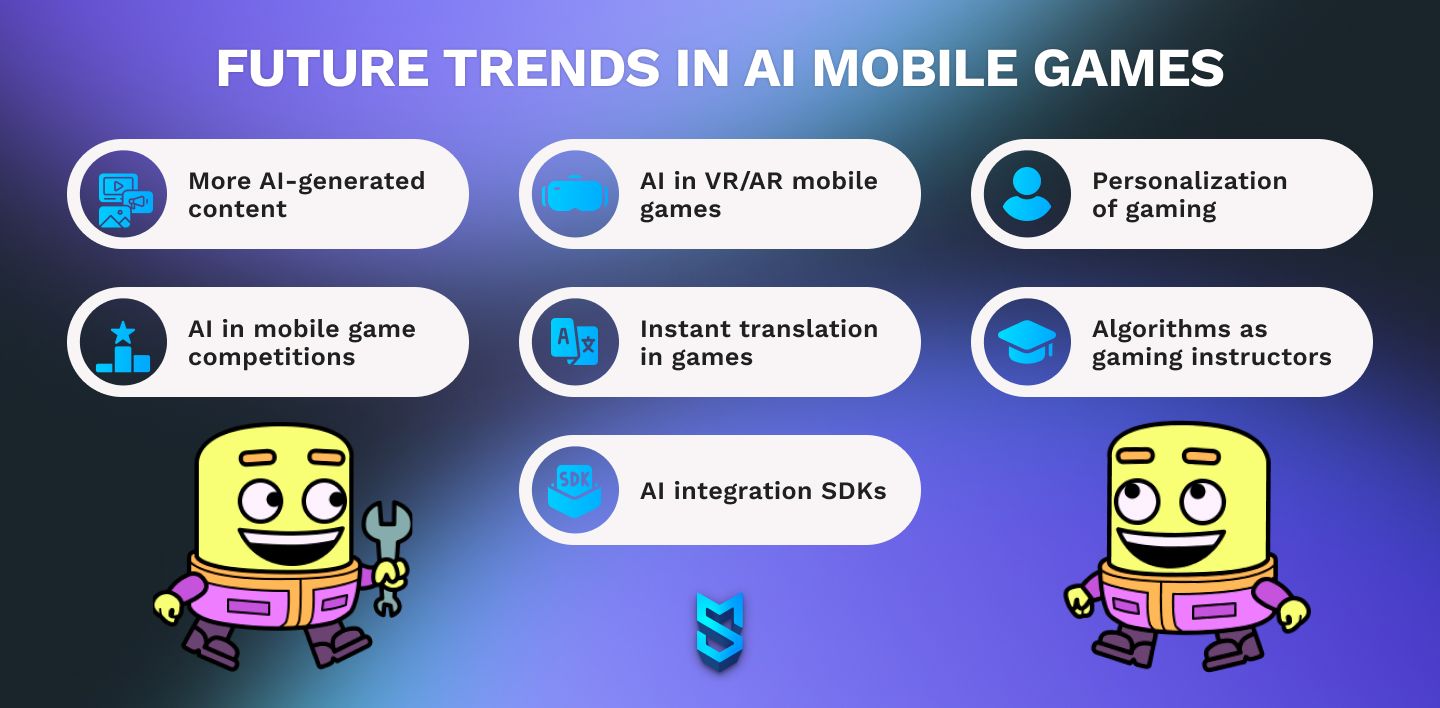
What’s in the cards for the marriage between mobile games and artificial intelligence?
| More AI-generated content | From procedural content generation to AI-assisted art creation to AI-driven narrative, algorithms will inevitably become more involved in game content. The biggest obstacle to that right now is the ethical issue of generative AI training, as soon as it has some sort of resolution, the fusing of AI and content will speed up. |
| AI in VR/AR mobile games | Virtual and augmented reality games are the natural soil for AI integration. Mobile devices that already have VR/AR support have enough processing power to handle AI. |
| Personalization of gaming | We’re living in the time when personalization of all experiences is already a trend. Since this is one of the main benefits AI offers to game developers, this trend will continue to grow. |
| AI in mobile game competitions | Algorithms are great at matchmaking, can train on the go, and can instantly detect cheating. The perfect mix for competitions. |
| Instant translation in games | Globalization created demand for quality instant translation, and AI algorithms that can evolve are ideal for this service. Gaming communities are also among the most active international spaces, which makes them well-suited for AI to flourish. |
| Algorithms as gaming instructors | In competitive gaming, AI will garner more attention for its potential as teacher. Algorithms trained on large amounts of gaming data will help analyze competitions and train players for future rounds. |
| AI integration SDKs | With the expensiveness of creating AI from scratch, software development kits (SDKs) for AI integration will see a big rise in demand. Companies will want to cut costs, and where there’s demand, there always comes supply. SDK developers will answer this call. |
Case studies: Successful AI integration
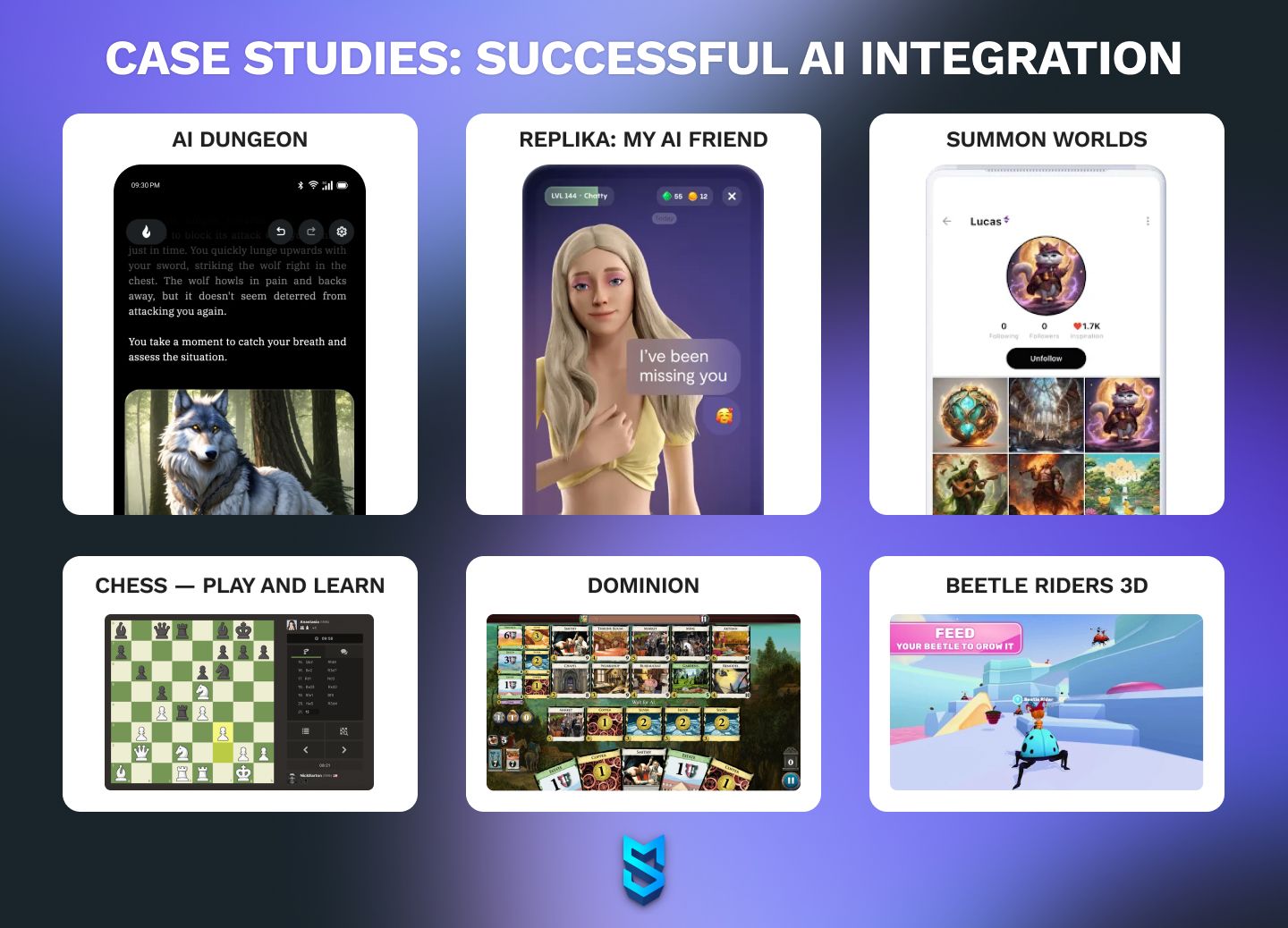
There aren’t too many, but we’re already seeing mobile games built using artificial intelligence. With the market not oversaturated yet, it’s the perfect time to jump in with AI games of your own.
AI Dungeon
You can’t have your cake and eat it too? Think again 😆 AI Dungeon is a game for those who want to try creating a story of their own and play it right away, not really knowing what’s next. This game offers players to set the place, and then it spins the story, changing it in reaction to the player’s further input.
As multiple players’ reviews say, the narrative isn’t perfect — sometimes the algorithm forgets something it created before — but overall, it’s a pretty successful example of generative AI in game development.
Replika: My AI Friend
A chatbot game powered by artificial intelligence. Players can create a conversation partner to talk to, tailor them in both appearance and temperament. There’s also AR support so that players can engage with the “friend” like they’re sitting next to them.
The downside is the high cost of subscription and the fact that you can’t pay monthly, only yearly. The free version is quite limited.
Chess — Play and Learn
Chess.com is one of the leading mobile games for chess lovers, and it’s been using AI-powered bots as opponents for some time already. AI here is able to learn during the game, players can analyze the game after it’s finished, see improvement recommendations, and more.
The game is also collaborating with Duolingo, the popular language learning app (which also has its share of gamification).
Summon Worlds
Another mobile game powered by generative AI, it offers players to create (“summon”) creatures — humans, monsters, other beings. The AI generates their backstory and appearance, and players can also converse with their creations.
Same as previous games with generative AI, it’s prone to lose the train of thoughts between prompts. But that’s the issue not with the game but with the current stage of generative AI development in general.
Dominion
A medieval fantasy-styled deck-building card game based on the physical tabletop game of the same name that’s been around since 2009. In the mobile game version, players can choose to play against an AI built with a deep learning neural network algorithm.
Beetle Riders 3D
A game by us, Mind Studios Games. It’s a multiplayer IO racing game where players create an avatar and compete with others in racing on beetles. The game has opponents enhanced by a pathfinding AI algorithm. Check it out on Google Play and Apple App Store.
AI techniques for mobile games
If you’re interested in a bit more technical glance, in a table below, we describe some techniques of artificial intelligence for use in mobile games. The primary objective of most of these is to make video games more personalized and engaging for players.
Types of AI techniques for mobile games
Rule-based AI decision-making systems |
These AI algorithms use rules — created by developers, of course — to build more natural-looking NPC behavior. For example, movement patterns where NPCs and enemies avoid obstacles on their way instead of going “through” them (pathfinding algorithms). Or NPC reacting to certain actions by players, like ducking when a player’s character “hits” them or clapping when the player does some performance near them. Such decision-making systems can have strictly defined rules or can utilize machine learning (ML). |
Decision tree AI |
A decision tree is a complex system, sometimes utilizing machine learning. They’re used for different purposes:
|
Swarm AI |
Taught based on insect behavior patterns, swarm algorithms create behavior in NPCs or enemies. For example, when the player gets into one enemy’s area of detection and all enemies further away also come and attack them; or enemies will attack a single player all together, but will divide when there’s a party, adapting to the environment. NPC crowds that react to environment changes (e.g., moving vehicles controlled by players or another AI) also use Swarm AI algorithms. Another use of Swarm AI in games is when a game offers AI bots as co-players. These co-players, while not being controlled by other players, will still exhibit social behaviors: protect the player in a battle, adjust formation to cover for teammates, etc. |
Machine learning (ML) |
In a nutshell, machine learning is the type of algorithms that are able to self-educate and self-improve without explicit programming. As artificial intelligence in game development, it means that the system processes live data from players and automatically adjusts itself. ML can be used to, among other things:
ML can be supervised or unsupervised, though the former is preferable at the current stage of technology evolution. |
Reinforcement learning (RL) |
RL is an ML technique that makes algorithm learn from interacting with environment via rewards and penalties. The algorithm performs an action and, based on the response from the environment (for example, a player), it adjusts the next action to receive a better reward or fewer penalties. |
Neural networks |
Combined with ML algorithms, neural networks help developers create lifelike NPCs that change behavior over time and based on the changes in the player’s character. |
Deep learning |
Deep learning is a subset of ML and neural networks. It uses multi-layered (or deep) neural networks to further enhance the decision-making processes. In video games, it can be used for speech and image recognition, augmented reality, and natural language processing. |
AI for procedural content generation (PCG) |
AI-backed PCG is a quick way to create diverse random events and quests for the players, e.g., randomly spawning NPCs with micro quests or items on sale for discounts. In open-world games, different NPCs might respawn in the same place, or the same NPCs can give out a variety of quests. PCG is also responsible for the seemingly random loot drops from enemies. With AI game development, this randomness can be adjusted to bring each player the best gaming experience — for example, the items enemies drop will correspond with the player’s class or level. |
Fuzzy logic AI |
These algorithms are another technology responsible for making lifelike NPCs and enemies. Humans don’t always operate logically, and we don’t always have the full information. In a same way, an NPC built with fuzzy logic will behave unexpectedly. |
Natural Language Processing (NLP) |
It’s already possible to build NPC-player interactions with NLP algorithms, where NPCs react and reply to information provided directly by players — in written or spoken form. Though it is quite complex. |
Computer vision |
Computer vision in mobile games is used mostly for games with Augmented Reality (AR) like Pokémon Go, Jurassic World Alive, and The Walking Dead: Our World. It is an AI technique that allows algorithms to interpret visual data. Computer vision is used in AR games to place virtual objects in the game so that they look like they’re part of the real-world environment. In non-AR games, it can be used to create avatars and characters in players’ likeness by using face recognition. |
Conclusion
The possibilities artificial intelligence in game development opens for game companies are numerous and varied, which is why AI will only grow in the industry. It can help big game development companies make games faster without loss in quality. And it offers an opportunity for smaller and indie game devs to bring to the market something highly competitive without having to invest an AAA+ budget.
While there are questionable practices and multiple other obstacles on the path of AI in mobile games, those are conquerable if given some time.
We at Mind Studios Games are keeping our eyes on this topic, and we’re trying out the technology already. If you’re interested in AI game creation in general or already have an idea, we can provide assistance. Contact us for a free consultation!

